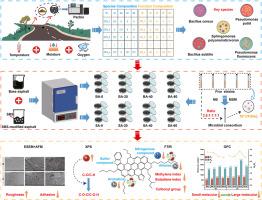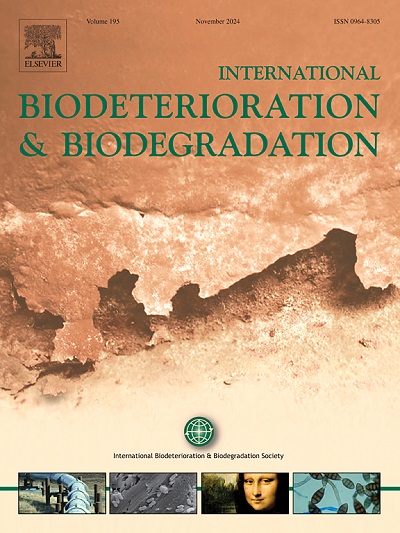Biodegradation mechanism of asphalt by microbial consortia in asphalt pavement of forest area road
IF 4.1
2区 环境科学与生态学
Q2 BIOTECHNOLOGY & APPLIED MICROBIOLOGY
International Biodeterioration & Biodegradation
Pub Date : 2024-09-27
DOI:10.1016/j.ibiod.2024.105930
引用次数: 0
Abstract
To study the degradation behaviors of asphalt by microorganisms and reveal biodegradation mechanism of asphalt, 16S rRNA full-length sequencing was utilized to analyze the collected samples from three forest areas. Five strains, namely Sphingomonas polyaromaticivorans, Pseudomonas putida, Pseudomonas fluorescens, Bacillus cereus, and Bacillus subtilis, were selected for compounding microbial consortium to study its degradation effects on asphalt. The micromorphology, elemental chemical states, micromechanical properties, molecular weight distribution, and functional groups of degraded asphalt were studied using environmental scanning electron microscopy, X-ray photoelectron spectroscopy, atomic force microscopy, gel permeation chromatography, and Fourier transform infrared spectroscopy. The results show that the biodegradation of asphalt by microbial consortium increases the surface roughness of asphalt and reduces surface adhesion. Asphalt is used as the sole carbon source by microbial consortium, resulting in a continuous decrease in the contents of C and N elements, while the content of O element is continuously increased. Simultaneously, under the action of microbial enzymes, C-C/C-H bonds which are combined with molecular oxygen in asphalt are continuously broken and converted to C-O-C/C-O-H bonds. The continuous reductions in methylene index and butadiene index of asphalt, as well as the production of carbonyl functional groups confirm the oxidative degradation of asphalt by microbial consortium. Additionally, with the extension of degradation time, the large molecular substances in asphalt are gradually degraded by microbial consortium, leading to a more concentrated molecular weight distribution. This study is of great importance to understand biodegradation mechanism of asphalt.

林区道路沥青路面微生物群对沥青的生物降解机理
为了研究微生物对沥青的降解行为,揭示沥青的生物降解机理,研究人员利用16S rRNA全长测序技术对从三个林区采集的样品进行了分析。选取多芳香单胞菌、腐生假单胞菌、荧光假单胞菌、蜡样芽孢杆菌和枯草芽孢杆菌五株菌株组成复合微生物群,研究其对沥青的降解作用。利用环境扫描电子显微镜、X 射线光电子能谱、原子力显微镜、凝胶渗透色谱法和傅立叶变换红外光谱法研究了降解沥青的微观形态、元素化学态、微观力学性质、分子量分布和官能团。结果表明,微生物群对沥青的生物降解增加了沥青的表面粗糙度,降低了表面附着力。微生物群以沥青为唯一碳源,导致 C、N 元素含量持续下降,而 O 元素含量持续上升。同时,在微生物酶的作用下,沥青中与分子氧结合的 C-C/C-H 键不断断裂并转化为 C-O-C/C-O-H 键。沥青的亚甲基指数和丁二烯指数的持续降低以及羰基官能团的产生证实了微生物群对沥青的氧化降解作用。此外,随着降解时间的延长,沥青中的大分子物质逐渐被微生物群降解,导致分子量分布更加集中。这项研究对了解沥青的生物降解机理具有重要意义。
本文章由计算机程序翻译,如有差异,请以英文原文为准。
求助全文
约1分钟内获得全文
求助全文
来源期刊
CiteScore
9.60
自引率
10.40%
发文量
107
审稿时长
21 days
期刊介绍:
International Biodeterioration and Biodegradation publishes original research papers and reviews on the biological causes of deterioration or degradation.

 求助内容:
求助内容: 应助结果提醒方式:
应助结果提醒方式:


